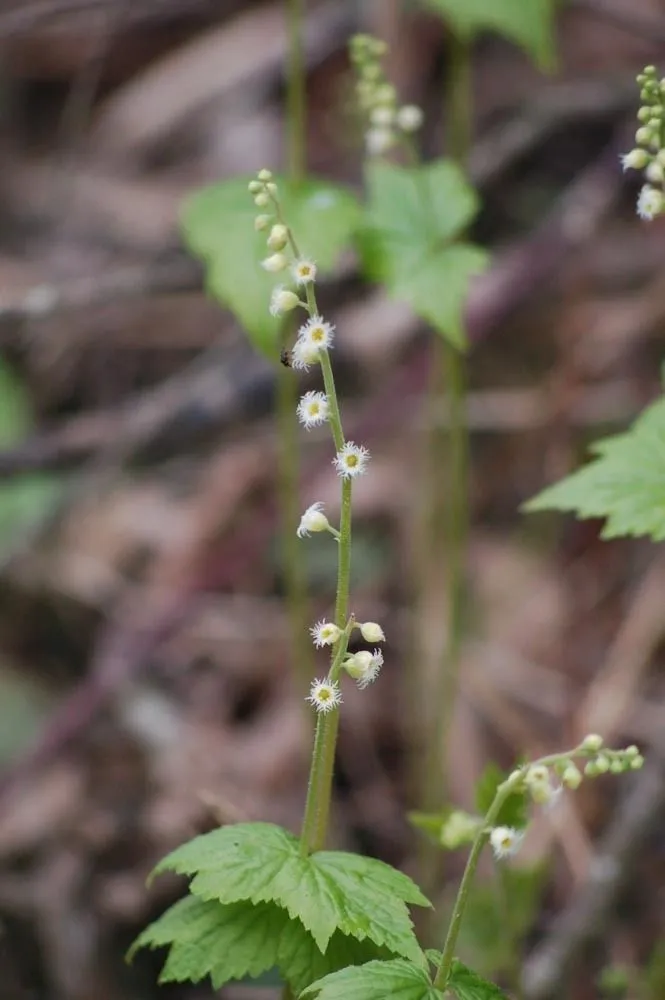
Author: L.
Bibliography: Sp. Pl.: 406 (1753)
Year: 1753
Status: accepted
Rank: species
Genus: Mitella
Vegetable: False
Observations: E. Canada to NC. & E. U.S.A.
Bishop’s-cap, scientifically known as Mitella diphylla, is a delicate herbaceous perennial plant that belongs to the Saxifragaceae family. Originally described by Carl Linnaeus in 1753 in his seminal work “Species Plantarum,” this species is native to the eastern regions of North America, spanning from eastern Canada through to North Carolina and extending across the eastern United States.
This charming woodland plant typically thrives in rich, moist, deciduous forests where it enjoys dappled sunlight and well-draining soil. The name “Bishop’s-cap” is derived from the unique shape of its tiny, white, star-shaped flowers, which resemble a bishop’s ceremonial headpiece. The plant produces a slender, erect stem that can reach up to 50 centimeters in height, with distinctive, opposite leaves that are heart-shaped or sometimes lobed.
Mitella diphylla is often admired for its intricate floral structure, which features a series of fringed, cup-shaped petals. These flowers bloom in late spring to early summer, providing a delicate and ethereal display in forest understories. The plant’s leaves form a basal rosette, and sometimes a pair of leaves can be seen halfway up the stem, lending the species its epithet “diphylla” which means “two leaves.”
In terms of ecological significance, Bishop’s-cap plays a vital role in woodland ecosystems. It provides nectar for a variety of pollinators, including small bees and flies, ensuring the continued propagation of the species. Additionally, its foliage offers a habitat and food source for numerous forest invertebrates, contributing to the biodiversity of its natural habitat.
Cultivating Mitella diphylla in a garden setting can be rewarding, especially for gardeners focusing on native plants or woodland gardens. Its low-maintenance nature and adaptability to shaded environments make it an ideal addition to garden beds that simulate forest conditions. When cultivated under appropriate conditions, Bishop’s-cap requires minimal care and can naturalize quite well, forming charming patches that bring a touch of wild beauty to cultivated spaces.
In summary, Bishop’s-cap is a modest yet striking plant that enriches the areas it inhabits both ecologically and aesthetically. Its delicate flowers and shade-loving demeanor make it a cherished component of North America’s eastern woodland flora.
Eng: bishop’s-cap, coolwort, miterwort, two-leaf mitella, two-leaf mitrewort, twoleaf miterwort, two-leaved mitrewort, coolwort mitrewort, two-leaved bishop’s-cap
Swe: vitluva
Nob: frynselue
Nno: frynseluve
Fra: mitrelle à deux feuilles, mitrelle deux-feuilles
En: Bishop’s-cap, Miterwort, Coolwort, Two-leaf mitella, Two-leaf mitrewort, Twoleaf miterwort, Two-Leaf Bishop’s-Cap, Two-leaved Mitrewort, Coolwort mitrewort, Two-leaved bishop’s-cap
Fr: Mitrelle à deux feuilles, Mitrelle deux-feuilles
Nb: Frynselue
Nn: Frynseluve
Sv: Vitluva
Taken May 10, 2017 by huy HO (cc-by-sa)
Taken May 9, 2013 by EOL − Joe (cc-by-nc)
Taken May 8, 2013 by EOL − hobiecat (cc-by-nc)
Taken Feb 1, 2013 by EOL − Susan Elliott (cc-by-nc)
Taken May 1, 2021 by c fleet (cc-by-sa)
Taken Apr 24, 2021 by JT Burns (cc-by-sa)
© copyright of the Board of Trustees of the Royal Botanic Gardens, Kew.
Taken May 9, 2015 by EOL − roy pilcher (cc-by-nc)
Taken May 31, 2003 by EOL − Steven J. Baskauf (cc-by-nc-sa)
Taken May 31, 2003 by EOL − Steven J. Baskauf (cc-by-nc-sa)
Taken Jan 1, 1900 by EOL − John Hilty (cc-by-nc)
Taken Sep 18, 2013 by EOL − Charlie Hohn (cc-by-nc)
Taken Dec 2, 2014 by EOL − Erika Mitchell (cc-by-nc)
Taken Jan 2, 2015 by EOL − smwhite (cc-by-nc)
Taken May 12, 2014 by EOL − roy pilcher (cc-by-nc)
Taken May 5, 2014 by EOL − Christopher Tracey (cc-by-nc-sa)
Taken Apr 29, 2014 by EOL − Scott Schuette (cc-by-nc)
Taken Jun 3, 2012 by EOL − Everett (cc-by-nc-sa)
Taken May 12, 2015 by EOL − bendingtree (cc-by-nc)
Taken May 31, 2003 by EOL − Steven J. Baskauf (cc-by-nc-sa)
Taken May 31, 2003 by EOL − Steven J. Baskauf (cc-by-nc-sa)
Taken Nov 11, 2014 by EOL − Evan Raskin (cc-by-nc)
Taken May 12, 2015 by EOL − bendingtree (cc-by-nc)
Taken Oct 23, 2015 by EOL − yefersonherrera001 (cc-by-nc)
Growth habit>: Forb/herb
Family: Myrtaceae Author: (F.Muell.) K.D.Hill & L.A.S.Johnson Bibliography: Telopea 6: 402 (1995) Year: 1995 Status:…
Family: Rubiaceae Author: Pierre ex A.Froehner Bibliography: Notizbl. Bot. Gart. Berlin-Dahlem 1: 237 (1897) Year:…
Family: Sapindaceae Author: Koidz. Bibliography: J. Coll. Sci. Imp. Univ. Tokyo 32(1): 38 (1911) Year:…
Family: Asteraceae Author: A.Gray Bibliography: Pacif. Railr. Rep.: 107 (1857) Year: 1857 Status: accepted Rank:…
Family: Fabaceae Author: Medik. Bibliography: Vorles. Churpfälz. Phys.-Ökon. Ges. 2: 398 (1787) Year: 1787 Status:…
Family: Aspleniaceae Author: (Cav.) Alston Bibliography: Bull. Misc. Inform. Kew 1932: 309 (1932) Year: 1932…